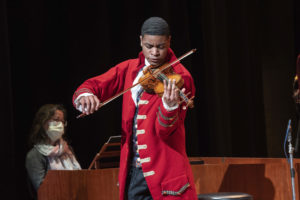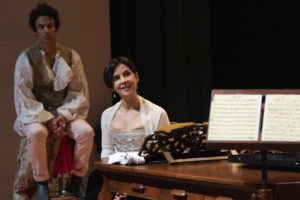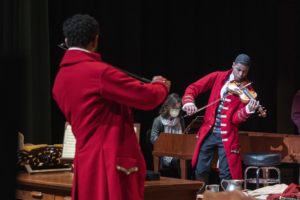
 [rating=3]“The Chevalier” is a uniquely conceived performance that tells an unknown story about the life of Joseph Bologne, Chevalier de Saint-Georges, a black/biracial man who served in the 18th century court of French king Louis XVI. A knight of the king, musical composer, expert fencer, abolitionist, and virtuoso violinist, Saint-Georges was acquainted with the composer Wolfgang A. Mozart, the novelist Pierre Choderlos de Laclos (who wrote “Dangerous Liaisons”), and Queen Marie Antoinette, his dearest champion. Had he been a white man, Saint-Georges would have been considered a powerhouse in so many ways; instead he suffered from racial discrimination and was subject to taunts and threats of bodily harm. In addition, he could never land a good job or meet the appropriate wife to start a family. This story, based on actual events and persons, is elegant, highly crafted, and fascinating. And the best part is that it includes authentic music written by Saint-Georges. Although there are lots of fine elements in this show, its structure is far from perfect. An analogy can be made to the workings of a fine Swiss watch: The movement needs to be properly calibrated even when the jewels within it are superb.
[rating=3]“The Chevalier” is a uniquely conceived performance that tells an unknown story about the life of Joseph Bologne, Chevalier de Saint-Georges, a black/biracial man who served in the 18th century court of French king Louis XVI. A knight of the king, musical composer, expert fencer, abolitionist, and virtuoso violinist, Saint-Georges was acquainted with the composer Wolfgang A. Mozart, the novelist Pierre Choderlos de Laclos (who wrote “Dangerous Liaisons”), and Queen Marie Antoinette, his dearest champion. Had he been a white man, Saint-Georges would have been considered a powerhouse in so many ways; instead he suffered from racial discrimination and was subject to taunts and threats of bodily harm. In addition, he could never land a good job or meet the appropriate wife to start a family. This story, based on actual events and persons, is elegant, highly crafted, and fascinating. And the best part is that it includes authentic music written by Saint-Georges. Although there are lots of fine elements in this show, its structure is far from perfect. An analogy can be made to the workings of a fine Swiss watch: The movement needs to be properly calibrated even when the jewels within it are superb.
The first jewel is the storyline. “The Chevalier” is a combination of a condensed biography and a series of vignettes featuring the “black knight” while he is a courtier in Paris and Versailles. Director and playwright Bill Barclay must be congratulated for his hefty research in discovering the many interesting details and aspects of Saint-Georges’ life and music. We are still in the process of learning more about this extraordinary man, whose father was a white plantation owner and his mother, a slave from Senegal.
The second jewel is the musical performance. The star of the show by far is Brendon Elliott, the soloist on violin. He plays Saint-Georges’ compositions with such heart and vigor that he is a force to be reckoned with! Behind him is the Music of the Baroque orchestra, conducted by musical director Dame Jane Glover. The entire show is a collaboration between Music of the Baroque (MOB) and Concert Theatre Works, and MOB never fails to satisfy!
The third jewel is Barclay’s creative presentation of Saint-Georges. Separating the man into two characters—that of the musician, embodied by Elliott, and that of all other aspects of his persona, portrayed by R.J. Foster—is ingenious. Elliott is African-American as is Foster, and both are dressed in the exact same 18th-century garb. Of course, the audience quickly makes the connection that they are supposed to be one and the same person. Designer Charles Schoonmaker has done a great job crafting gorgeous period costumes for Elliott, Foster, and the rest of the cast to recreate a once-gilded era prior to the French Revolution of 1789. Hence, we have the fourth jewel of the show, where Mozart (David Joseph), Laclos (Bill Barclay), and Marie Antoinette (Merritt Janson) serve as foils for Saint-Georges to bring out his character via the invented dialogue among all of them.
What takes away from the show’s luster is a lack of coordination between the acting, the script, the music, and the technical elements. Part of the problem is that it is not clear whether this production is meant to be a play with music, a theatrical concert, or a concert theater work. And herein hangs a tale. Unfortunately, a lot of the biography about Saint-Georges has been turned into a “data dump”, and we in the audience are provided with much more than what we can absorb at once. Yes, we are very interested in learning more about the life history of this largely undiscovered composer; but with so much being thrown at us, it becomes nearly impossible to unpack all of this in the course of ninety minutes. What’s more problematic is that we need to see more action unfold on stage rather than just being told the story. There are too many times when Barclay breaks character and addresses the audience as if he were also the narrator; in other words, he doesn’t just act as Laclos but also acts the part of the playwright (which, of course, he is!). Although the action is supposed to take place in the second half of 1778, we are later informed about the course of Saint-Georges’ life during and after the French Revolution and also regarding the events surrounding his death in 1799. Laclos’s verbal account is very interesting but seems out of place, and perhaps a summary of these later years might be better served by appearing in the program notes instead—or by making some other changes to the script.
The show not only devolves into a history lesson but also a lesson in musical composition that can best be understood by those already familiar with baroque music or who have some understanding of how instrumental music is put together. While I learned something from these explanations, my feeling is that this goes over the heads of most people in a general audience who have not had the luxury of a music education. Hence the larger questions become: Who exactly is meant to be in the audience? And how do the discussions between Mozart, Marie Antoinette, and Saint-Georges about the intricacies of music further the overall plot?
Projection design was a major problem on the night I watched the show; it worked less than half the time. The play would have been much easier to follow had we seen slides labeled “Prologue”, “Scene I”, etc., all the way through “Epilogue.” The names of the musical compositions can be found on page 11 of the program, but slides containing this information should have made its way to the projection screen, located above the orchestra. Speaking of the orchestra, the musicians should have been positioned behind a scrim, except for Elliott on violin. This would have added dramatic tension to the performance.
“The Chevalier” is clearly a work-in-progress. The underlying biography is amazing. The incorporation of Saint-Georges’ instrumental music is exceptional, and Elliott’s violin playing is extraordinary. Despite the wonderfully creative concept behind the production and the delightful acting on the part of the performers, the production as a whole can certainly be improved. Sure enough, we learn from Barclay during the aftertalk that he is seeking out additional funding so as to revamp the concert into more of a play that tells Saint-Georges’ story at length. If that’s the direction that the show is going, then it needs to flow better with less narration, and the story ought to be better focused. The result should look somewhat more like an opera but with dialogue and no singing, backed by instrumentals, as compared to the current situation where actors step in front of the orchestra to say their lines and then sit on stools when they are not being featured. Yet in my opinion, a revised script might be better suited to a movie than a play. Visual effects can allow for the overlay of the violinist with the actor playing Saint-Georges. And unlike the limitations of a live stage presentation, a larger portion of the life story could be shown rather than merely told. Consequently, the audience won’t have to do so much heavy lifting.
There were only three performances of “The Chevalier”: at the Kehrein Center for the Arts, in Austin, on Friday, February 19th; the North Shore Center for the Performing Arts on Saturday, February 20th; and at Chicago’s Symphony Center on Sunday, February 21st.
Note that all the venues require proof of vaccination or a negative Covid-19 test. Please be prepared to show your ID and vaccination card. Masking is mandatory indoors.
For more information about “The Chevalier”, go to: https://www.baroque.org/chevalier. On this webpage, you can also listen to music being performed in the show.
For general information about Music of the Baroque, please go to their website: https://www.baroque.org/ or contact their box office at: 312-551-1414.






More Stories
“Seth’s Broadway Concert Series”
2025 Glenbrook North Variety Show
“Cookie”